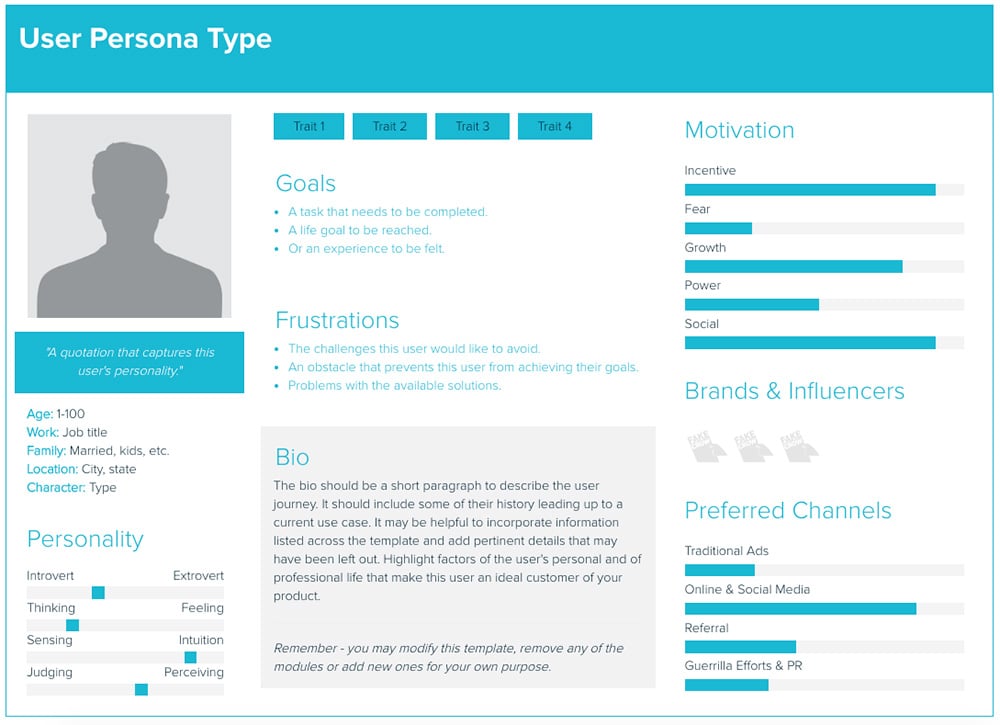Step by Step Guide: How to Develop User Personas

Digital Marketing
Building Your User Personas
It’s no secret companies committed to their customers are the ones most likely to succeed. Of course, to provide excellent customer experience, you have to really understand and know your target audience. Just guessing at what your target market wants won’t get you very far. That’s why successful businesses invest time in developing user personas (also known as buyer personas).
User personas are semi-fictional characters that represent a segment of your customer base. By creating user personas to describe your typical customers, you can better identify and solve your customers’ problems, develop products with the best product/market fit, and strengthen your brand’s marketing across the board.
In short, any department in your company that affects customers can benefit from user personas, which is why some organizations spend thousands of dollars to hire researchers or use fancy persona generating software to develop their buyer personas. But developing user personas doesn’t have to be complicated or expensive.
In this post, you’ll learn a simple but effective 5-step process any company can use to develop user personas. Let’s get started.
Step 1: Review what you already know about your target audience.
There are three extremely valuable sources of information you already have access to right now: employee knowledge, website/social analytics, and competitor analysis.
Employee Knowledge
To compile employee knowledge of your customer base, have a meeting with your entire team or representatives from each department. You’ll glean unique insights from different team members; the sales team can report on common objections to buying, while the customer service team can make you aware of recurring complaints. All this information can help you begin to look for trends and archetypes in your target audience.
Website/Social Analytics
Individual assumptions and observations will be a helpful starting point, but you’ll also want to see how the data supports or contradicts your team’s opinions. Your website and social media analytics can provide a wealth of valuable information as you move forward.
For example, review what you know about the demographic information of your customers, the content that draws the most eyes, the email subject lines that get the greatest response, and the keywords that drive visitors to your site. All of this data can reveal insightful trends in the problems your target audience faces and the answers they’re hoping you can provide.
Competitor Analysis
Competitor analysis can also provide a wealth of useful information as you prepare to develop user trends. Scan your competitors’ online reviews for negative feedback that can both equip you to better assist their underserved customers and open your eyes to opportunities for improvement in your own customer experience.
There are also tools that make it easy to monitor your competition and learn about the members of your target audience they’re attracting. (Click here for a list of those tools and other tips on monitoring the competition.)
Take notes on target market trends that emerge through employee knowledge, website/social analytics, and competitor analysis to refer back to as you move forward with the next step of buyer persona development.
Step 2: Gather information from your customers to fill in the gaps.
Once you review what you know, it’s time to fill in the gaps and dig a bit deeper into what motivates your customers. The most effective way to understand your target market is to simply ask them.
There are many ways you can gather information from customers. Email surveys and website forms can help you reach a lot of people and get more data, while interviews in person, on the phone, or via video conference will allow you to probe deeper and uncover more detail.
Which method you use is up to you, and you can even test or combine a few methods to see what works best for you. However you decide to survey your customers, you’ll need to compile a list of questions to ask them.
You can click here to access a free customer survey template or create your own. Just make sure you’re asking questions to uncover the following:
- Demographics - Information about age, race, education, job title, or income level can provide a good starting point for your buyer personas.
- Goals - Customers buy when they believe you can help them achieve their goals, so make sure you understand what those goals are.
- Barriers - You’ll want to uncover the barriers your customers face in achieving their goals so you can provide tools that help. It’s also a good idea to dig into any barriers that keep your target audience from buying from you or that prevent them from having a positive experience once they do buy.
Step 3: Decide how many user personas your company needs.
After reviewing what you know and surveying customers to learn more, you’ll have a lot of data on your hands. Before you can make sense of that data with buyer personas, you should consider exactly how many user personas your company needs.
Look back over the information you’ve gathered. See if any trends emerge that can help you segment your target market into a few groups of customers that have certain characteristics and experiences in common.
This step of developing a user persona is all about balance. If you limit yourself to one or two buyer personas, you’ll likely be too broad and fail to capture specific characteristics that would help you understand your target market. On the other hand, if you have more than five buyer personas, it will be hard to keep them straight and remember them down the road, limiting the likelihood your team will actually put any of the user personas to use.
While the exact number will depend on your industry and target market, three to five user personas is a good range for most businesses.
Step 4: Create a user persona template.
The numbers and data you’ve compiled so far are helpful, but now it’s time to make sense of that data by creating your user personas. Remember—customers aren’t just numbers. They’re real people with real goals and real problems, and they’re trusting you to help them.
A user persona template will provide you a framework to create semi-fictional customer archetypes your team can use to better understand and relate to your customers.

Your user persona template should have spaces to fill in the trends and information that emerge in your data. The exact categories you include are up to you, but here are a few suggestions to get you started:
- Name - Buyer persona names help humanize your data and give your team someone to picture when solving problems for your customers. Your team will be able to refer back to “Sarah,” for example, in team meetings and instantly be on the same page about the target market segment you’re discussing or serving.
- Demographics - You can be as detailed or basic as you wish, but information like age, income, education level, and even a detailed, semi-fictional background story can really bring your user persona to life.
- Job Title and Industry - Whether you’re B2B or B2C, you’re still selling to and serving real people who hold jobs, and the types of jobs they hold can reveal a lot about your customers’ daily life, interests, skills, goals, and problems.
- Goals and Motivation - Consider what your target audience wants to accomplish and why. When you go beyond the surface and consider emotional motivations as well, your buyer personas can help shape more empathy and understanding among team members in your marketing and customer service departments.
- Pain Points - Consider those barriers your customers typically face to accomplishing their goals, hiring your company, or having a positive customer experience. Once you can understand and solve your target market’s problems, you’ll attract customers and turn them into brand ambassadors who happily spread the word to their friends, family, and colleagues.
- Bonus Tip - Find a photo for each user persona you create using stock images. The more lifelike, the better! Photos are an easy way to help your team visualize and relate to the target audience you’re trying to serve.
Once you create your user persona templates, simply fill them in using the trends you’ve uncovered in your research.